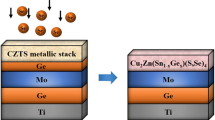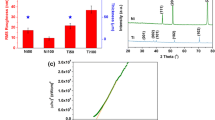Abstract
Lithium doping is beneficial for enhancing the performance of Cu2ZnSn(S,Se)4 (CZTSSe) thin film solar cells. However, the conventional doping strategy of spin-coating of the precursor ink containing Li source suffers from mass loss due to Li redissolution during the layer-by-layer deposition. In this study, we report an effective Li-doping strategy for preparing CZTSSe thin film on a flexible Mo foil substrate via the doctor-blading approach. In addition, we investigate the effect of Li doping on device performance. The grain size becomes larger with increasing Li-doping content, which could be attributed to the Li–Se liquid phase formation during the selenization process. Moreover, lithium can enter the CZTSSe lattice, and it tends to accumulate on the surface, passivating the defects and improving the functionality of the p–n junction. Thus, an appropriate Li-doping content enhances device performance. Furthermore, the strategy of codoping with Li and Na is preliminarily explored. Interestingly, the results reveal that introducing Na enhances the Raman signal of S vibration at 328 cm−1 compared with that of the 10%-Li sample. The efficiency of the flexible CZTSSe solar cells is further improved to 7.59%. Thus, this work provides a simple and effective strategy for Li doping via the doctor-blading method and demonstrates the interplaying mechanism between the codoped Li and Na.

摘要
锂掺杂有利于提高铜锌锡硫硒薄膜太阳电池的性能. 然而, 传统旋涂含锂前驱体溶液的掺杂策略在前驱膜的逐层沉积过程中, 由于锂的再溶解而导致大量的锂流失. 在本工作中, 我们通过刮涂法在柔性钼箔衬底上制备了铜锌锡硫硒薄膜, 实现锂的有效掺杂, 并进一步研究了锂掺杂对器件性能的影响. 随着锂掺杂含量的增加, 吸收层晶粒尺寸变大, 这可能与硒化过程中锂–硒液相的形成有关. 而且, 锂可以进入铜锌锡硫硒晶格中, 并在吸收层的表面积累, 从而钝化缺陷, 提升p–n结质量. 因此, 适量的锂掺杂可以提高器件的性能. 此外, 本工作探索了锂–钠共掺的影响. 有趣的是, 与Li-10%样品相比, 钠元素的引入增强了吸收层拉曼光谱在328 cm−1处硫的振动信号. 10%锂钠共掺可将柔性Cu2ZnSn(S,Se)4 薄膜太阳电池的效率进一步从6.62%提高到7.59%. 本工作提供了一种基于刮涂法、简单有效的锂掺杂策略, 并证明了锂–钠共掺存在相互作用机制.
Similar content being viewed by others
References
Giraldo S, Jehl Z, Placidi M, et al. Progress and perspectives of thin film kesterite photovoltaic technology: A critical review. Adv Mater, 2019, 31: 1806692.1806691
Sahu M, Minnam Reddy VR, Park C, et al. Review article on the lattice defect and interface loss mechanisms in kesterite materials and their impact on solar cell performance. Sol Energy, 2021, 230: 13–58
Wang P, Wu Y, Cai B, et al. Solution-processable perovskite solar cells toward commercialization: Progress and challenges. Adv Funct Mater, 2019, 29: 1807661
Gour KS, Karade V, Babar P, et al. Potential role of kesterites in development of earth-abundant elements-based next generation technology. Sol RRL, 2021, 5: 2000815
Gong Y, Zhang Y, Jedlicka E, et al. Sn4+ precursor enables 12.4% efficient kesterite solar cell from DMSO solution with open circuit voltage deficit below 0.30 V. Sci China Mater, 2020, 64: 52–60
Green MA, Dunlop ED, Yoshita M, et al. Solar cell efficiency tables (version 62). Prog Photovoltaics, 2023, 31: 651–663
Xu X, Zhou J, Yin K, et al. 12.84% Efficiency flexible kesterite solar cells by heterojunction interface regulation. Adv Energy Mater, 2023, 13: 2301701
Duan B, Shi J, Li D, et al. Underlying mechanism of the efficiency loss in CZTSSe solar cells: Disorder and deep defects. Sci China Mater, 2020, 63: 2371–2396
Sun L, Wang W, Hao L, et al. Influence mechanism of Cd ion soaking on performance of flexible CZTSSe thin film solar cells. Mater Sci Semiconductor Processing, 2022, 138: 106301
Wang S, Huang L, Ye Z, et al. Fabrication of high-efficiency Cu2(Zn,Cd)SnS4 solar cells by a rubidium fluoride assisted co-evaporation/annealing method. J Mater Chem A, 2021, 9: 25522–25530
Sun Y, Guo H, Qiu P, et al. Na-doping-induced modification of the Cu2ZnSn(S,Se)4/CdS heterojunction towards efficient solar cells. J Energy Chem, 2021, 57: 618–626
Xie H, López-Marino S, Olar T, et al. Impact of Na dynamics at the Cu2ZnSn(S,Se)4/CdS interface during post low temperature treatment of absorbers. ACS Appl Mater Interfaces, 2016, 8: 5017–5024
Sun K, Liu F, Huang J, et al. Flexible kesterite Cu2ZnSnS4 solar cells with sodium-doped molybdenum back contacts on stainless steel substrates. Sol Energy Mater Sol Cells, 2018, 182: 14–20
Xin H, Vorpahl SM, Collord AD, et al. Lithium-doping inverts the nanoscale electric field at the grain boundaries in Cu2ZnSn(S,Se)4 and increases photovoltaic efficiency. Phys Chem Chem Phys, 2015, 17: 23859–23866
Cabas-Vidani A, Haass SG, Andres C, et al. High-efficiency (LixCu1−x)2ZnSn(S,Se)4 kesterite solar cells with lithium alloying. Adv Energy Mater, 2018, 8: 1801191
He M, Zhang X, Huang J, et al. High efficiency Cu2ZnSn(S,Se)4 solar cells with shallow LiZn acceptor defects enabled by solution-based Li post-deposition treatment. Adv Energy Mater, 2021, 11: 2003783
Shen Z, Wang S, Liu Y, et al. Li2S doping into CZTSe drives the large improvement of VOC of solar cell. J Energy Chem, 2021, 62: 637–644
Guo H, Wang G, Meng R, et al. An efficient Li+-doping strategy to optimize the band alignment of a Cu2ZnSn(S,Se)4/CdS interface by a Se&LiF co-selenization process. J Mater Chem A, 2020, 8: 22065–22074
Cancino-Gordillo FE, Cab JV, Pal U. Structure and transport behavior of hydrothermally grown phase pure Cu2ZnSn1−xGexS4 (x = 0.0, 0.3) nanoparticles. Appl Surf Sci, 2021, 571: 151261
Chang X, Fu J, Kou D, et al. Synergistic incorporation of NaF and CsF PDT for high efficiency kesterite solar cells: Unveiling of grain interior and grain boundary effects. J Mater Chem A, 2021, 9: 413–422
Rey G, Babbe F, Weiss TP, et al. Post-deposition treatment of Cu2ZnSnSe4 with alkalis. Thin Solid Films, 2017, 633: 162–165
Zhou J, Xu X, Duan B, et al. Regulating crystal growth via organic lithium salt additive for efficient kesterite solar cells. Nano Energy, 2021, 89: 106405
Xu H, Ge S, Yang W, et al. 9.63% Efficient flexible Cu2ZnSn(S,Se)4 solar cells fabricated via scalable doctor-blading under ambient conditions. J Mater Chem A, 2021, 9: 25062–25072
Yan Q, Sun Q, Deng H, et al. Enhancing carrier transport in flexible CZTSSe solar cells via doping Li strategy. J Energy Chem, 2022, 75: 8–15
Mule A, Vermang B, Sylvester M, et al. Effect ofdifferent alkali (Li, Na, K, Rb, Cs) metals on Cu2ZnSnSe4 solar cells. Thin Solid Films, 2017, 633: 156–161
Zhao X, Chang X, Kou D, et al. Lithium-assisted synergistic engineering of charge transport both in GBs and GI for Ag-substituted Cu2ZnSn(S,Se)4 solar cells. J Energy Chem, 2020, 50: 9–15
Lin X, Madhavan VE, Kavalakkatt J, et al. Inkjet-printed CZTSSe absorbers and influence of sodium on device performance. Sol Energy Mater Sol Cells, 2018, 180: 373–380
Salomé PMP, Rodriguez-Alvarez H, Sadewasser S. Incorporation of alkali metals in chalcogenide solar cells. Sol Energy Mater Sol Cells, 2015, 143: 9–20
Wang Y, Lv S, Li Z. Review on incorporation of alkali elements and their effects in Cu(In,Ga)Se2 solar cells. J Mater Sci Tech, 2022, 96: 179–189
Hsieh YT, Han Q, Jiang C, et al. Efficiency enhancement of Cu2ZnSn(S,Se)4 solar cells via alkali metals doping. Adv Energy Mater, 2016, 6: 1502386
Yang Y, Kang X, Huang L, et al. Tuning the band gap of Cu2ZnSn(S,Se)4 thin films via lithium alloying. ACS Appl Mater Interfaces, 2016, 8: 5308–5313
Yang Y, Huang L, Pan D. New insight of Li-doped Cu2ZnSn(S,Se)4 thin films: Li-induced Na diffusion from soda lime glass by a cation-exchange reaction. ACS Appl Mater Interfaces, 2017, 9: 23878–23883
Dong XF, Zheng TT, Yang FX, et al. An effective Li-containing interfacial-treating strategy for performance enhancement of air-processed CZTSSe solar cells. Sol Energy Mater Sol Cells, 2021, 227: 111102
Zhang J, Zhang W, Cheng HM, et al. Critical review of recent progress of flexible perovskite solar cells. Mater Today, 2020, 39: 66–88
Schnabel T, Abzieher T, Friedlmeier TM, et al. Solution-based preparation of Cu2ZnSn(S,Se)4 for solar cells—Comparison of SnSe2 and elemental Se as chalcogen source. IEEE J Photovoltaics, 2015, 5: 670–675
Ge S, Xu H, Khan SN, et al. A universal and facile method of tailoring the thickness of Mo(Sx,Se1−x)2, contributing to highly efficient flexible Cu2ZnSn(S,Se)4 solar cells. Sol RRL, 2021, 5: 2100598
Khan SN, Ge S, Huang Y, et al. Highly efficient Cu2ZnSn(S,Se)4 bifacial solar cell via a composition gradient strategy through the molecular ink. Sci China Mater, 2021, 65: 612–619
Zhang X, Han D, Chen S, et al. First-principles study on the alkali chalcogenide secondary compounds in Cu(In,Ga)Se2 and Cu2ZnSn(S,Se)4 thin film solar cells. J Energy Chem, 2018, 27: 1140–1150
Gong Y, Zhu Q, Li B, et al. Elemental de-mixing-induced epitaxial kesterite/CdS interface enabling 13%-efficiency kesterite solar cells. Nat Energy, 2022, 7: 966–977
Hobson TDC, Hutter OS, Fleck N, et al. Vegard relation and Raman band reference data generated from bulk crystals of kesterite-phase composition series Cu2ZnSnS4xSe4−4x (CZTSSe, 0 ⩽x ⩽ 1). Cryst Growth Des, 2020, 20: 2164–2173
Schorr S, Gurieva G, Guc M, et al. Point defects, compositional fluctuations, and secondary phases in non-stoichiometric kesterites. J Phys Energy, 2020, 2: 012002
Moser S, Tiwari AN, Carron R. Interplay between Li and Na amid codoped solution-processed Cu2ZnSn(S,Se)4 absorbers for solar cells. Sol Energy Mater Sol Cells, 2023, 250: 112094
Maeda T, Kawabata A, Wada T. First-principles study on alkali-metal effect of Li, Na, and K in Cu2ZnSnS4 and Cu2ZnSnSe4. Phys Status Solidi C, 2015, 12: 631–637
Ishizuka S, Taguchi N, Nishinaga J, et al. A comparative study of the effects of light and heavy alkali-halide postdeposition treatment on CuGaSe2 and Cu(In,Ga)Se2 thin-film solar cells. Sol Energy, 2020, 211: 1092–1101
Reinhard P, Bissig B, Pianezzi F, et al. Features of KF and NaF postdeposition treatments of Cu(In,Ga)Se2 absorbers for high efficiency thin film solar cells. Chem Mater, 2015, 27: 5755–5764
Jackson P, Wuerz R, Hariskos D, et al. Effects of heavy alkali elements in Cu(In,Ga)Se2 solar cells with efficiencies up to 22.6%. Physica Rapid Res Ltrs, 2016, 10: 583–586
Hegedus S, Shafarman W, et al. Thin-film solar cells: Device measurements and analysis. Prog Photovolt, 2004, 12: 155–176
Yan Q, Cheng S, Yu X, et al. Mechanism of current shunting in flexible Cu2Zn1−xCdxSn(S,Se)4 solar cells. Sol RRL, 2020, 4: 1900410
Khan SN, Ge S, Gu E, et al. Bifacial Cu2ZnSn(S,Se)4 thin film solar cell based on molecular ink and rapid thermal processing. Adv Mater Inter, 2021, 8: 2100971
Acknowledgements
This work was supported by the Basic and Applied Basic Research Projects of Guangdong Province of China (2021A1515110520), the National Natural Science Foundation of China (62074168), China Postdoctoral Science Foundation (2021M703655), and the funding from the State Key Laboratory of Optoelectronic Materials and Technologies at Sun Yat-Sen University (OEMT-2022-ZTS-08). We also thank Prof. Zongcun Liang, Prof. Ruijiang Hong, Prof. Wan Yue, Prof. Zhengke Li, and Prof. Fang Yi for the facility and characterization support.
Author information
Authors and Affiliations
Contributions
Author contributions Lin X conceived and supervised the project; Xu H conducted most of the experiments and wrote the draft of the manuscript with support from all the authors; Ge S, Wang T and Gu E participated in the discussion and analysis of the data. All the authors participate in the general discussion.
Corresponding authors
Ethics declarations
Conflict of interest The authors declare that they have no conflict of interest.
Additional information
Supplementary information Supporting data are available in the online version of the paper.
Han Xu received her Master’s degree in materials physics and chemistry from Sun Yat-Sen University in 2022. Currently she is pursuing her doctoral degree at the Institute of Photoelectronic Thin Film Devices and Technology, Nankai University. Her research interest includes the synthesis and characterization of energy materials and their applications in optoelectronic devices. Her current research focuses on flexible kesterite Cu2ZnSn(S,Se)4 thin-film solar cells.
Ening Gu received her PhD degree in materials science from Friedrich-Alexander-Universität Erlangen-Nürnberg in 2019 under the supervision of Prof. Christoph J. Brabec. Currently, she works as a postdoctoral fellow at the School of Materials Science and Engineering, Sun Yat-Sen University. Her research interests focus on emerging photovoltaic materials, solution-processed optoelectronic semiconductors and devices.
Xianzhong Lin received his PhD degree from the Technische Universität Berlin, Germany, in 2014. Before joining Sun Yat-Sen University as an associate professor in 2017, he worked as a postdoctoral researcher at Helmholtz-Zentrum Berlin für Materialien und Energie and Friedrich-Alexander-Universität Erlangen-Nürnberg for three years. His research focuses on highly efficient and stable thin-film solar cells based on printing approaches.
Electronic supplementary material
Rights and permissions
About this article
Cite this article
Xu, H., Ge, S., Wang, T. et al. Flexible Cu2ZnSn(S,Se)4 thin film solar cells with lithium doping via doctor blading. Sci. China Mater. 67, 67–75 (2024). https://doi.org/10.1007/s40843-023-2670-6
Received:
Accepted:
Published:
Issue Date:
DOI: https://doi.org/10.1007/s40843-023-2670-6




